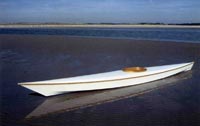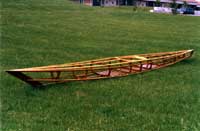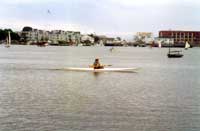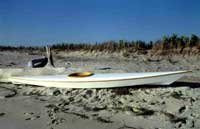It was a regular contributor to
Duckworks Magazine who bought a set of Egret plans
and then suggested that I approach Chuck about making
them available online. Now they are. Click HERE
to order plans.
Egret is a seventeen foot skin-on-frame
kayak with an easily assembled fuselage frame and
a variety of covering options. One could cover it
with traditional canvas, but the included building
manual focuses on heat-shrink Dacron. This aircraft
fabric can be used alone, sealed with paint or varnish,
or it can be covered with clear Hypalon. Another
option is to sheathe the Dacron with a layer of
Xynole and epoxy. This kind of laminated skin is,
as far as I know, my own innovation, and it yields
an extremely tough yet light and flexible hull.
The following is adapted from
two articles previously published in Messing About
In Boats.

Introducing Egret
 |
Egret: a skin-on-frame
kayak
(click images
to enlarge) |
In 1959 my dad built a canvas-skinned kayak from
a kit. It had a wood frame that went together more
easily than a model airplane: a keel, a stem and a
stern, some bulkheads and frames positioned along
the keel, and stringers strung along the length to
give it shape. It was easy to build, was well used
for many years, and its frame still hangs from the
ceiling of my shop.
There are lots of good plans for homebuilt kayaks
on the market these days, but few are for skin boats.
Most of them are for plywood or strip plank construction.
The current trend in skin boats seems to be toward
personalized arctic replicas, which are beautiful
boats, but must be laboriously mortised, lashed, knotted
and stitched together. They are not easy to build.
 |
The current
trend in skin boats seems to be toward personalized
arctic replicas. They are not easy to build. |
Egret addresses this lack of graceful and easy-to-build
skin-on-frame kayaks with its fuselage-style construction,
and she also adds to the genre by utilizing newer
methods of covering a wood frame. Dad’s kit
was covered in canvas and shrunk taut with canvas
dope, which is still a strong and viable way to cover
a kayak, but modern materials provide attractive alternatives.
Heat-shrink Dacron, used on ultra-light aircraft
and boats, is much easier to attach to the frame than
canvas, and shrinks taut and wrinkle-free far more
easily. Dacron can be used by itself for minimal weight,
or it can be coated with Hypalon, which is now available
in a tough clear-coat form, UA-7090. A Dacron skin
can also be reinforced with a layer of laminating
fabric such as Xynole, set in epoxy, to form a tough
and flexible composite hull.
Egret is a stable and maneuverable kayak. She tracks
well yet turns easily. Her low profile and beveled
deck shed wind and water, and her high bow keeps her
above the waves. She was conceived by sifting through
all the attributes I liked in the native boats in
Adney & Chappelle and elsewhere, and by considering
the virtues and faults of contemporary kayaks.
 |
She tracks well
yet turns easily. Her low profile and beveled
deck shed wind and water, and her high bow keeps
her above the waves. |
The bulkhead-and-stringer-style skin kayak merits
a revival, and Egret aspires to lead the way. This
can be the cheapest, quickest and easiest way to build
your own kayak. Good looks, quality and performance
are part of the package.
Egret Prototype Report
After four seasons, the original Egret is every
bit as sound as she was the day she was launched.
Her heat-shrink Dacron skin with two coats of Hypalon
UA7090 has held up well. There are no leaks despite
much flexing in rough water, and also many highway-speed
air miles atop the car. It is an aircraft fabric,
after all. We almost found some rocks once at low
tide but leaned away at the last moment so there are
still no crash test data. The frame has held together
well, too. The epoxy joints at the intersection of
every frame and longitudinal allow an egg-crate distribution
of stresses and make for a light, strong and durable
boat.
The first person to paddle Egret other than myself
was the gentleman in the bracing photos. The occasion
was the 2004 John Gardner Small Craft Workshop at
the Mystic Seaport. He slid nimbly into the boat and
took her out for a spin on the river. Upon his return
he declared that she needed a skeg, then proceeded
to perform some kayak hydrobatics, bracing out with
the paddle and leaning the boat over. He braced out
progressively farther and leaned over until the coaming
was almost awash, then looked up at me and said “Won’t
go over.”
“That can be a good thing, too” I replied,
not entirely sure what he meant. He conveyed an air
of expertise, and for all I knew he might have been
the Shackleton of eskimo rolling, but Egret was not
designed as a rolling boat. Egret is a stable, seaworthy
kayak designed for the 98% of kayakers who prefer
to remain upright. The gentleman scurried off before
I could catch his name or plumb his thoughts.
He was correct about the skeg. He was an economically
proportioned person, slim of frame and not tall. I
am too, and being fully aware that many people weigh
more than I do, I incorporated more buoyancy aft than
I would have had the boat been designed for me alone
and not for the general public. And I, too, found
at first that the stern seemed to slew a bit from
side to side, mostly in flat water. When I watched
my slim sister, who weighs the same 130 pounds and
stands the same five foot eight as I do, paddle Egret
about, I could see that the stern floated a little
high, just skimming the water at the aftmost end of
the keel. But I have also watched folks who are in
the 160-180 lb. range paddle Egret, and her stern
settles right down into the water and she tracks just
fine. So now the prototype, my personal kayak, has
a skeg, and now she tracks like a bloodhound on rails.
I therefore recommend that a skeg be added if the
primary paddler of an Egret weighs less than 150 lbs.
My skeg is 1 7/8” deep at the aft end of the
keel and tapers to 3/16” just aft of the cockpit.
I suspect that 1/2 to 2/3 of that depth is all that’s
really necessary. It might not need to be that long,
either. A smaller skeg would generate less friction
(theoretically) but the prototype shows no decrease
in speed. If anything she’s faster, since more
of the paddler’s energy is channeled into going
straight. She still turns fairly well, since rocker
is maintained forward. She turns very quickly if you
spin her atop a wave.
 |
She still turns
fairly well, since rocker is maintained forward.
She turns very quickly if you spin her atop
a wave. |
Egret has danced through wild water at the eastern
gates of Long Island Sound and has soldiered through
many a Bayliner wake. Only in the steepest of those
wakes does she pierce the wave, and then the water
slides harmlessly around the coaming and off the deck.
The only thing as satisfying as having one’s
design objectives work out not only on paper but on
the water is the attention Egret attracts at the boat
launch and elsewhere. I can’t get her into the
water without at least a “Nice kayak.”
Often the comments and questions are more expansive.
My favorite is the time I pulled into the Post Office
with Egret atop the car. First the Postmaster came
bounding out the door to have a closer look, saying
“Beautiful boat.” An elderly lady was
crossing the parking lot and added, in her elderly-lady
voice, “It’s not just a boat; it’s
a work of art.” I had to go home and change
my undershirt.
It is my sincere hope that the readers of Duckworks
Magazine will agree with the Postmaster and the elderly
lady. Plans, full-size patterns and a detailed instruction
book are $70.
Click
here to order plans

|